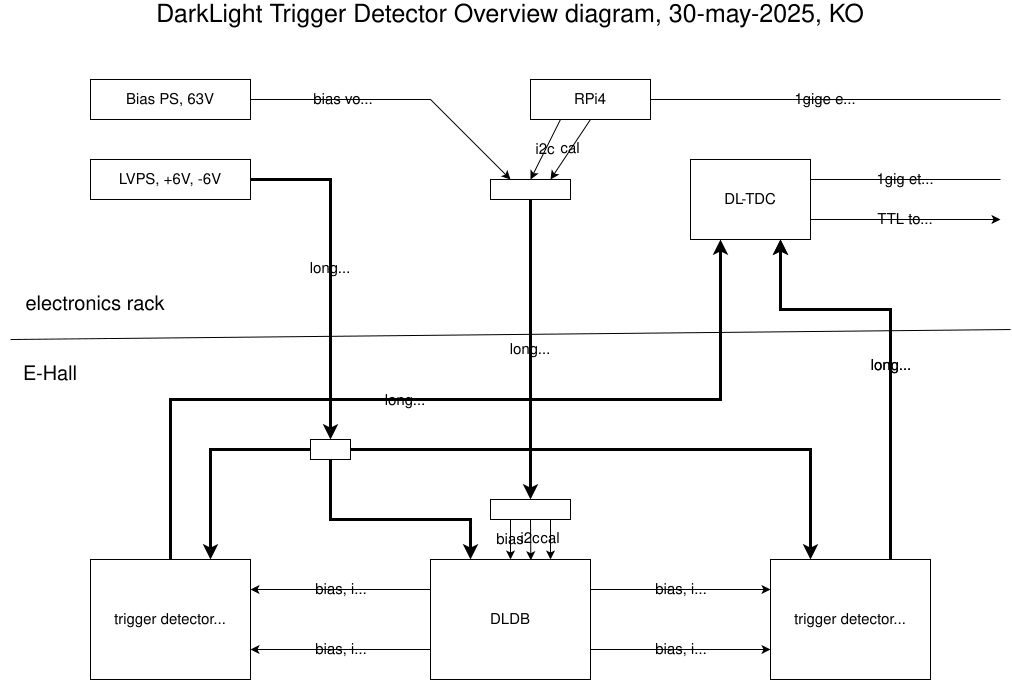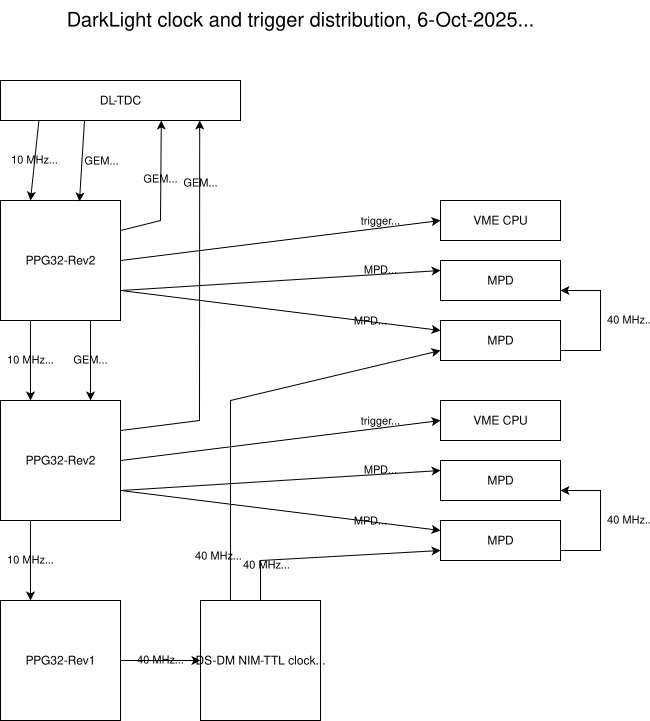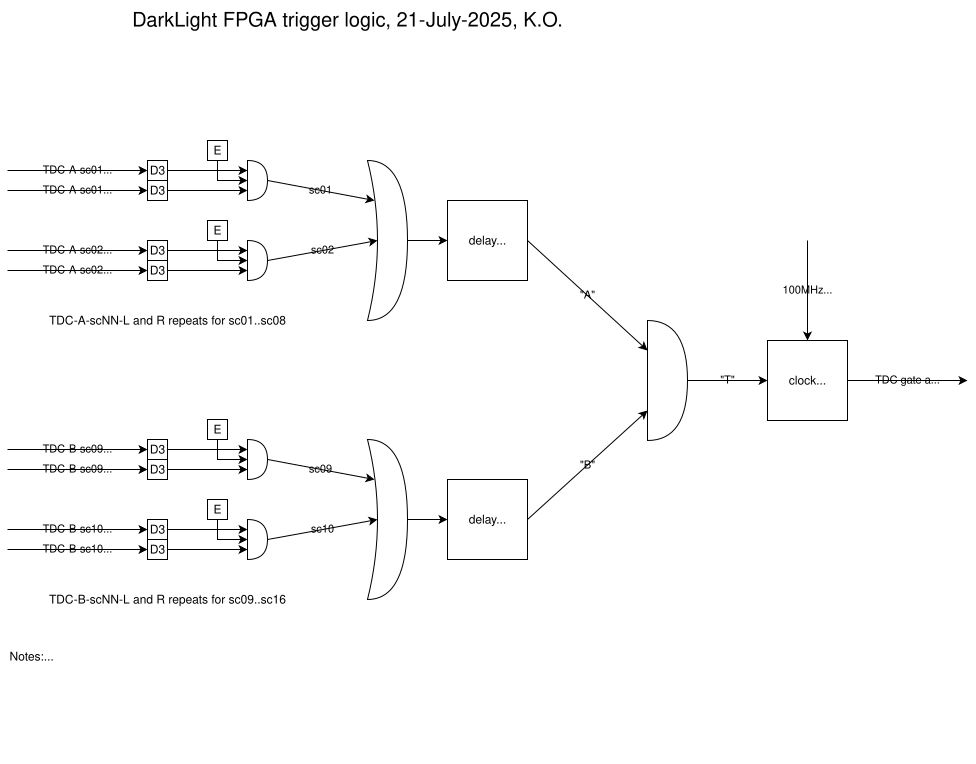DarkLight: Difference between revisions
| Line 168: | Line 168: | ||
* JMP3 - left (TTL input) | * JMP3 - left (TTL input) | ||
* P0, P2 - both left (TTL output) | * P0, P2 - both left (TTL output) | ||
* P1, P3 - both right (NIM output) | * P1, P3, P4 - both right (NIM output) | ||
* SW1 - 0 (VME address) | * SW1 - 0 (VME address) | ||
* SW2 - 0 (VME address) | * SW2 - 0 (VME address) | ||
Revision as of 18:29, 2 October 2025
DarkLight experiment at TRIUMF
Links
- https://web.accel.triumf.ca/elinac_elog/frames.pl
- https://driverdisplays.dev.kube.dmz.triumf.ca/elinac
- https://daq00.triumf.ca/mhttpd-dl/
- https://daq00.triumf.ca/elog-dl/
- https://dl-server-2/slowctrl/
- https://daq13.triumf.ca - detector facility daq station
- https://daq17.triumf.ca - MOB GEM lab daq station
- git clone dldaq@daq00.triumf.ca:public_html/git/dlana - trigger detector analysis software
- DL-DB - trigger detector SiPM board and distribution board documentation
- https://daq00.triumf.ca/AgWiki/index.php/Chronobox - DL-TDC base firmware documentation
- DL-TDC - DL-TDC special documentation
- VME-PPG32 - PPG32 documentation
- VME-NIMIO32#DL_clock_(PPG32) - PPG32 (IO32) firmware documentation
- chronobox_firmware branch dl-tdc - DL-TDC firmware git repo
- chronobox_software - DL-TDC MIDAS frontend git repo
- (to be split) dldb - fedldb git repo
Drawings
Please click on the SVG-format drawings to see the full image with full text (mediawiki preview truncates the text)
SVG format - trigger detector diagram
SVG format - trigger and clock distribution
NB: this drawing is out of date. As of 1oct2025, we use 3 PPG32:
- PPG32-Rev2 top crate, clock+trig from DL-TDC, veto1 to DL-TDC
- PPG32-Rev2 bot crate, clock+trig from top PPG32, veto2 to DL-TDC
- PPG32-Rev1 bot crate, clock from bot PPG32-Rev2
- DS-DM 40 MHz clock distributor bot crate, clock in from PPG32-Rev1, clock out to top MPDs and clock out to bot MPDs
- top and bot MPDs clock is daisy chained from left to right modules
SVG format - FPGA trigger logic=
PDF format drawings
- File:DL-trigger-detector.drawio.pdf
- File:DL-trigger-clock.drawio.pdf
- File:DL-trigger-fpga.drawio.pdf
DAQ
- ODB /eq/cb02/settings:
- dl_ctrl for A+B 0xC0FE
- dl_ctrl for A*B 0xC0F0
- A is grand-OR of all scintillators on the TDC-A cable (enabled by dl_trg_mask[7..0], 8 bits for the 8 scintillators)
- B is grand-OR of all scintillators on the TDC-B cable (enabled by dl_trg_mask[15..8], 8 bits for the 8 scintillators)
- each scintillator signal (A[7..0] and B[7..0]) is L*R hardwired in dl/dl.sv
- dl_tdc_mask can be used to disable each of the 32 TDC inputs (see map between TDC inputs and scintillator channels)
- there is no button to disable chronobox counters and rates for individual CB channels
Detector map from Gabby
- Electron side detector (A-side)
ch16 - tdc04 - B8 - sc08 - B7 - tdc09 - ch08 ch15 - tdc05 - B8 - sc07 - B7 - tdc08 - ch07 ch14 - tdc12 - B6 - sc06 - B5 - tdc03 - ch06 ch13 - tdc13 - B6 - sc05 - B5 - tdc02 - ch05 ch12 - tdc06 - B4 - sc04 - B3 - tdc11 - ch04 ch11 - tdc07 - B4 - sc03 - B3 - tdc10 - ch03 ch10 - tdc14 - B2 - sc02 - B1 - tdc01 - ch02 ch09 - tdc15 - B2 - sc01 - B1 - tdc00 - ch01
TDC cabling map
This TDC map is hardcoded in the analyzer and in the FPGA trigger logic.
Orange and Black detectors TDC cable connections are the same.
TDC cable A is tdc00..tdc15 TDC cable B is tdc16..tdc31 A signal is tdc32 B signal is tdc33 T = A*B is tdc34
TDC end | SiPM | scintillator | SiPM | TDC end ------------------------------------------------ tdc01 | B1 | sc01, sc02 | B2 | tdc14-15 tdc10-11 | B3 | sc03, sc04 | B4 | tdc67 tdc23 | B5 | sc05, sc06 | B6 | tdc12-13 tdc89 | B7 | sc07, sc08 | B8 | tdc45 ------------------------------------------------
DLDB port map
DLDB scintil channel SiPM scint port lator ----------------------------------------- 0 - sc01 sc02 - ch01 ch02 - eB1 - e1 - e2 1 - sc02 sc01 - ch09 ch10 - eB2 - e2 - e1 2 - sc03 sc04 - ch03 ch04 - eB3 - e3 - e4 3 - sc04 sc03 - ch11 ch12 - eB4 - e4 - e3 4 - sc05 sc06 - ch05 ch06 - eB5 - e5 - e6 5 - sc06 sc05 - ch13 ch14 - eB6 - e6 - e5 6 - sc07 sc08 - ch07 ch08 - eB7 - e7 - e8 7 - sc08 sc07 - ch15 ch16 - eB8 - e8 - e7 8 - sc09 sc10 - ch17 ch18 - pB1 - p1 - p2 9 - sc10 sc09 - ch25 ch26 - pB2 - p2 - p1 10 - sc11 sc12 - ch19 ch20 - pB3 - p3 - p4 11 - sc12 sc11 - ch27 ch28 - pB4 - p4 - p3 12 - sc13 sc14 - ch21 ch22 - pB5 - p5 - p6 13 - sc14 sc13 - ch29 ch30 - pB6 - p6 - p5 14 - sc15 sc16 - ch23 ch24 - pB7 - p7 - p8 15 - sc16 sc15 - ch31 ch32 - pB8 - p8 - p7
FPGA and TDC channel map
sc01 - ch01 - tdc00 - GPIO-1-20 sc01 - ch09 - tdc15 - GPIO-1-21 sc02 - ch02 - tdc01 - GPIO-1-22 sc02 - ch10 - tdc14 - GPIO-1-23 sc03 - ch03 - tdc10 - GPIO-1-31 sc03 - ch11 - tdc07 - GPIO-1-34 sc04 - ch04 - tdc11 - GPIO-1-29 sc04 - ch12 - tdc06 - GPIO-1-32 sc05 - ch05 - tdc02 - GPIO-1-24 not GPIO-1-30 sc05 - ch13 - tdc13 - GPIO-1-25 sc06 - ch06 - tdc03 - GPIO-1-26 sc06 - ch14 - tdc12 - GPIO-1-27 sc07 - ch07 - tdc08 - GPIO-1-35 sc07 - ch15 - tdc05 - GPIO-1-30 sc08 - ch08 - tdc09 - GPIO-1-33 sc08 - ch16 - tdc04 - GPIO-1-28 sc09 - ch17 - tdc16 - GPIO-0-15 sc09 - ch25 - tdc31 - GPIO-0-14 sc10 - ch18 - tdc17 - GPIO-0-13 sc10 - ch26 - tdc30 - GPIO-0-12 sc11 - ch19 - tdc26 - GPIO-0-4 sc11 - ch27 - tdc23 - GPIO-0-1 sc12 - sc20 - tdc27 - GPIO-0-6 sc12 - ch28 - tdc22 - GPIO-0-3 sc13 - ch21 - tdc18 - GPIO-0-11 sc13 - ch29 - tdc29 - GPIO-0-10 sc14 - ch22 - tdc19 - GPIO-0-9 sc14 - ch30 - tdc28 - GPIO-0-8 sc15 - ch23 - tdc24 - GPIO-0-0 sc15 - ch31 - tdc21 - GPIO-0-5 sc16 - ch24 - tdc25 - GPIO-0-2 sc16 - ch32 - tdc20 - GPIO_0-7
PPG32-Rev2 settings
Jumper settings
- JMP1 - left (INP)
- JMP2 - left (INP)
- JMP3 - left (TTL input)
- P0, P2 - both left (TTL output)
- P1, P3, P4 - both right (NIM output)
- SW1 - 0 (VME address)
- SW2 - 0 (VME address)
- SW3 - C (VME A24 address 0xC0'0000)
Connections
LEMO_IN 3-4 | not used LEMO_IN 1-2 | TTL | 10 MHz clock and GEM trigger from DL-TDC ... LEMO OUT 9-10 | NIM | MPD trigger 100 ns long LEMO OUT 7-8 | NIM | 40 MHz clock to P.M. DS-DM TTL clock module LEMO_OUT 5-6 | TTL | 10 MHz clock and GEM trigger to next PPG32 LEMO_OUT 3-4 | NIM | MPD trigger 100 ns long LEMO_OUT 1-2 | TTL | busy out to DL-TDC
Note:
- clock and trigger daisy chain is TTL
Firmware sources
- cd $HOME/git
- git clone https://bitbucket.org/ttriumfdaq/vme-nimio32 vme-nimio32-dl-clock
- cd vme-nimio32-dl-clock
- git checkout dl-clock
Build firmware
- ssh trinatdaq ### must be Ubuntu-20 to run quartus 13.1
- cd /home/olchansk/git/vme-nimio32-dl-clock/VME-NIMIO32/PPG32-Rev1
- /daq/quartus/13.1.4.182/quartus/bin/quartus
- open VME-PPG32 project, processing -> start compilation
- will produce new sof and pof files (jic file must be regenerated manually)
- load sof file into FPGA using quartus jtag programmer, then load pof file into EPCS16 flasg using srunner, see below
Load firmware
- cd ~olchansk/git/vme
- ./srunner_vme_gef.exe -id -16 /dev/null 0x300020 ### identify EPCS chip
- ./srunner_vme_gef.exe -program -16 /home/olchansk/git/vme-nimio32-dl-clock/VME-NIMIO32/PPG32-Rev1/VME-PPG32.pof 0x300020
- ./test_VMENIMIO32_gef.exe --addr 0x300000 --reboot
Check clock status
- ./test_VMENIMIO32_gef.exe --addr 0x300000 --read 9 ### read clock status, bits are as above
- ./test_VMENIMIO32_gef.exe --addr 0x300000 --write 9 0 ### reset the pll_unlocked_latch
Update firmware on DL VME
- update vme-right
ssh daq@dl-server-2 cd olchansk/ppg32 cp /home/olchansk/git/vme-nimio32-dl-clock/VME-NIMIO32/PPG32-Rev1/VME-PPG32.pof . ssh vme-right cd olchansk/ppg32 srunner_vme -program -64 VME-PPG32.pof 0xc00020 srunner_vme -verify -64 VME-PPG32.pof 0xc00020 test_VMENIMIO32_gef --addr 0xc00000 --reboot io32 reg 4 write 0xbaadf00d io32 reg 0 reads 0x01250910 (old running firmware revision) io32 reg 0 reads 0x01250910 (should read 0xFFFFFFFF while FPGA is rebooting) io32 reg 0 reads 0xffffffff (should read 0xFFFFFFFF while FPGA is rebooting) io32 reg 0 reads 0x01251002 (new firmware revision) io32 reg 4 reads 0x00000000 (FPGA rebooted)
- repeat with 0xd00000
- repeat with vme-left
HP LVPS instructions
From: Gabby Gelinas <ggelinas@triumf.ca> Date: Mon, 23 Jun 2025 20:29:15 +0000 Hi all, Including the instructions on how to save the start up settings of the low voltage power supplies in case something changes and it needs to be redone again later. 1. Set the supplies to what you want them to default to 2. On one supply, press the blue button (says “save” above it) 3. Press "0" 4 Press “enter” 5. Repeat steps 2-4 on the other supply 6. Turn both supplies off 7. Turn both supplies on while holding down the “8” button to make sure it worked. You’ll see a message about loading save 0. Gabby Gelinas
TDC calibration pulser
TDC calibration pulser settings for 50 kHz rate:
- period: 20000
- duty_cycle: 1000
Procedure for TDC calibrations
fine time calibrations
The FPGA based DL-TDC must be calibrated before looking at the data and these calibrations must be periodically updated:
- record a cosmic run, mid.lz4 file size 500 Mbytes is good
- analyze: ./dlana.exe --mt --jsroot -R8082 /daq/data17/ehall/data/run01574.mid.lz4
- examine plots dltdc/file_time/tdcXX_fine_bins_le and _te, they should look like reference plots, for all channels
- examine plots fine_time_le and fine_time_te, if they are not flat and have severe distortions, calibrations must be updated
- make new fine time calibration file: ./dlana.exe --mt --jsroot -R8082 /daq/data17/ehall/data/run01574.mid.lz4 -- --dltdc-finetime
- edit dlcfmdb/dltdc_finetime.txt, add an entry for the new run
- re-analyze: ./dlana.exe --mt --jsroot -R8082 /daq/data17/ehall/data/run01574.mid.lz4
- reexamine the fine_time_le and _te plots, they should look flat now
- examine plots dltdc16/per-scintillator fine time plots/dltdc_scNN_t_NN_MM_FF. they should look like reference plots with small or no distortions.
- new calibrations are good. commit and push the new fine time calibration json and timetime.txt files in dlcfmdb.
pulser offsets
In addition, TDC offsets must be periodically checked and updated as needed:
- record a pulser run:
- pulser at 50 kHz (see settings above)
- sipm vbias off
- file size 500 Mbytes is good
- analyze: ./dlana.exe --mt --jsroot -R8082 /daq/data17/ehall/data/run01575.mid.lz4
- examine the tdc calibration plots, most channels should be good, some channels will show distortions, this as expected
- examine plots dltdc/pulser/tdc_pulser_le_vs_tdc_chan, _te_vs_tdc_chan and _width_vs_tdc_chan, they should be flat is in the reference plot
- _width_vs_tdc_chan should show 8 ns for all channels except tdc32 (A) and tdc34 (T), they should be 3 ns wide.
- if values observed are different, the offset calibration must be updated.
- make a new offset calibration file: ./dlana.exe --mt --jsroot -R8082 /daq/data17/ehall/data/run01575.mid.lz4 -- --dltdc-offsets
- edit dlcfmdb/dltdc_offsets.txt, add an entry for the new run
- re-analyze: ./dlana.exe --mt --jsroot -R8082 /daq/data17/ehall/data/run01575.mid.lz4 -- --dltdc-pulser
- pulser plots should now look as expected
- new calibrations are good. commit and push the new offsets calibration json file and offsets.txt file in dlcfmdb.
L-R offsets
Each trigger scintillator is read out from two end, left end and right end.
Ideally they should arrive to the trigger coincidence (L*R) at the same time, but because of unknown cable and electronics delays, one of them may arrive earlier. In this case, the L*R coincidence will always fire from the other signal (coincidence always fires not from the early signal but from the later signal), result is asymmetric triggering.
This is shown in the tHit-tA and tHit-tB plots. For each scNN, plots for the two ends (L and R) should look similar. The peak on the right is when this signal fires the L*R coincidence, the hump on the left is when the other (earlier) signal fires the coincidence. If hump on the left is absent or very small, it means this signal is the one that always fires the coincidence (always comes last), and to correct this, the other signal must be delayed. This is done by increasing the FPGA input pin D3 delay (and by inserting LCELL wire delays).
After all L*R coincidences are equalized in the trigger logic (by adjusting FPGA delays), they are zero-ed-out in the analysis program. The peak on the right is placed at time 0 on the plots.
(as of 1 Oct 2025) this is done manually. peak positions are read from the "tHit-tA and tHit-tB" plots and typed into the lr_offsets_runNNNN[] array in dltdc_module.cxx. Corresponding "if" statement is added in the code below.
For good L-R offsets calibration, plot dltdc16_trigNN_map should look similar to the reference plot.
For good L-R offsets calibration, the L-R time plots should be centered on zero.


